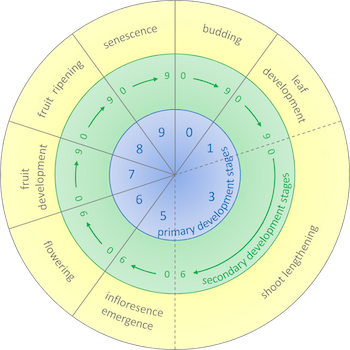What is the reference framework BBCH?
A phenological scale
The BBCH-scale has been adopted as an international scale to describe the phenological stages of plants. Originally developed at the German Biologische Bundesanstalt für Lans und Forstwirtschaft and published by Meier in 1997, it makes it possible to precisely characterize each developmental stage of the annual plant cycle with a combination of two digits. The tens digit represents a primary development stage (e.g. leaf development, flowering, etc.) and the units digit represents a secondary development stage. In primary development stage 0, the secondary stages correspond to morphological changes within the organ itself. For the other primary stages, the secondary stages from 0 to 9 correspond to the proportion of organs that have reached the primary stage concerned. To illustrate, BBCH stage 15 corresponds to the primary growth stage 1, “leaf development”, and to the secondary growth stage 5, referring to the percentage of unfolded leaves, in this case 50%.

The BBCH scale. According to “Phenological stages of monocotyledonous and dicotyledonous crops”. U. Meier. Blackwell Wissenschafts-Verlag Berlin. 2001.